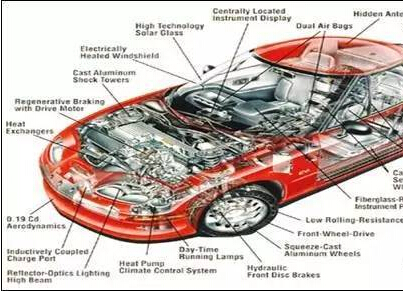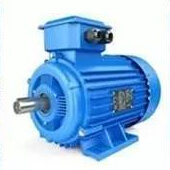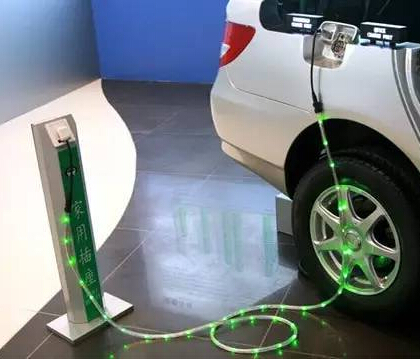Read the third heart of new energy vehicles: IGBT
First let's take a look. It is a composite fully-regulated voltage-driven power semiconductor device consisting of BJT (Bipolar Transistor) and MOS (Insulated Gate Field Effect Transistor). It has the characteristics of high input impedance and universal low-cost drive. Line; high speed switching characteristics; low on-state loss. The IGBT combines the advantages of both the high input impedance of the MOSFET and the low on-voltage drop of the GTR. The GTR saturation voltage is reduced, the current carrying density is large, but the driving current is large; the MOSFET driving power is small, the switching speed is fast, but the conduction voltage drop is large, and the current carrying density is small. IGBT combines the advantages of the above two devices: low driving power and reduced saturation voltage, which is a power electronic device suitable for medium and high power applications. IGBT has obvious advantages in comprehensive performance, and is very suitable for applications in converter systems with DC voltages of 600V and above, such as AC motors, inverters, switching power supplies, lighting circuits, traction drives, etc.
Therefore, it is not difficult to see that the value of IGBT for new energy vehicles is the role of DC charging piles and motor systems. It determines the working efficiency of the motor and the transmission efficiency of DC charging piles. IGBT accounts for about half of the cost of the motor drive system, and the motor drive system accounts for 15-20% of the total vehicle cost, which means that the IGBT accounts for 7-10% of the total vehicle cost, which is the second highest cost component except the battery. It also determines the energy efficiency of the vehicle.
IGBTs have a wide range of applications, not only for IGBTs in motor drives, but also for IGBTs in new energy generators and air conditioners. Therefore, some OEMs have firmly controlled this development in their own hands, such as Toyota's hybrid car. Toyota has also become the only manufacturer in the world that can independently produce IGBTs.
Not only the core of new energy vehicles, DC charging piles and locomotives (high-speed rail) are IGBT tubes, and the raw material cost of 30% of DC charging piles is IGBT. Electric locomotives generally require 500 IGBT modules, EMUs require more than 100 IGBT modules, and one metro requires 50-80 IGBT modules.
Mitsubishi Electric's HVIGBT has become the industry's default standard. China's high-speed locomotive IGBTs are completely monopolized by Mitsubishi. At the same time, Alstom, Siemens and Bombardier in Europe are more than half of Mitsubishi Electric's IGBTs.
In addition to Japanese manufacturers, Infineon has swept all the IGBTs of electric vehicles, and Mitsubishi Electric is intoxicated by the high profits of China's high-speed rail. It has almost nothing in the market below 2500V.
In 2016, the global electric vehicle sales volume was about 2 million units, which consumed about 900 million US dollars of IGBT tubes, averaging about 450 US dollars per vehicle. It is the most expensive part of electric vehicles except batteries.
Among them, there are about 770,000 hybrid and PHEVs, each requires about $300 IGBTs, about 1.23 million pure electric vehicles, an average of $540 per IGBT, and IGBTs for high-power pure electric buses. More than $1,000.
Compared with MOS, IGBT tubes have no advantage in low voltage fields below 400 volts. Regardless of switching frequency or cost, MOS advantages are very obvious. In the field of 400 volts, Fairchild Semiconductor, which was acquired by ON Semiconductor, is in a leading position.
The car is mainly between 600V and 1200V. Infineon has an overwhelming advantage. Although ON Semiconductor has a market in the field of 600V-1200V, it is mainly in the non-vehicle field. Mitsubishi and Fuji Electric shared the Japanese market. The IGBTs used in Toyota Hybrid are all completed internally, and they are not faked.
In an electric vehicle, the motor can be regarded as a compressor. The two principles are almost identical. Mainly control the IGBT switch by pulse width modulation (PWM), convert current from DC to AC (battery to motor, drive motor) or convert from AC to DC (motor to battery, brake, energy recovery when going downhill) Hybrid, in addition to the drive motor, there is also a generator that can be driven by the engine of the car, and then charged to the battery after AC/DC conversion by the IGBT module. In the DM model, the generator can also function as a drive motor.
The most common form of IGBT is actually a module, not a single tube. The three basic features of the module: multiple chips are assembled to the metal substrate in an insulating manner; the hollow plastic case is encapsulated, and the insulating material with air is high-pressure grease or silicone grease, and other possible soft insulating materials; the same manufacturer For the same technology series, the technical characteristics of the IGBT module are basically the same as those of the IGBT single tube of the same specification.
The main advantages of the module are as follows: multiple IGBT chips are connected in parallel, and the current specifications of the IGBT are larger. Multiple IGBT chips are combined in a specific circuit form, such as a half bridge, a full bridge, etc., to reduce the complexity of external circuit connections. Multiple IGBT chips are on the same metal substrate, which is equivalent to adding a soaking plate between the independent heat sink and the IGBT chip, which is more reliable. Multiple IGBT chips in a module have been screened by module manufacturers with better parameter consistency than commercially available discrete components. The connection between the multiple IGBT chips in the module is better than the external connection of a plurality of discrete single tubes, and the lead inductance is smaller. The module's external lead terminals are more suitable for high voltage and high current connections. For the same series of products from the same manufacturer, the highest voltage rating of the module is generally 1-2 higher than that of the IGBT single tube. If the maximum voltage specification of the single tube product is 1700V, the module has 2500V, 3300V or even higher voltage specifications.
One of the smallest fully functional units on the wafer is called Cell, the smallest unit after wafer splitting, and the chip unit that constitutes a single tube of IGBT or a unit of a module, collectively referred to as the die of an IGBT.
An IGBT die is called a unit of a module, also known as a module unit, the die of a module. The difference between the module unit and the IGBT die is that in the final product, the module unit does not have a separate package, and the die has an independent package to become an IGBT tube.
Recently, a module called IPM has been introduced to encapsulate the gate drive and protection circuit into the IGBT module. Although the structure is simple, the operating frequency cannot be too high. So there are fewer applications, let alone.
Although the cost of a single tube is much lower than that of a module, the reliability of a single tube is far less than that of a module. In the field of electric vehicles, the module has been applied on a large scale, but there are some exceptions. The old scooter with Chinese characteristicism and Tesla still insist on using a single tube. Can not help but feel that Tesla pays more attention to the cost than the importance of human life.
The Tesla Model X uses 132 IGBT tubes, supplied by Infineon, with 96 for the rear motor and 36 for the front motor. Each single tube costs about $4-5, for a total of about $650.
If you switch to a module, it is estimated that 12-16 modules are needed, costing about $1200-1600. The reason why Tesla uses a single tube is mainly the cost, especially its power is much larger than that of a general electric vehicle. In addition, the design development cycle is short, and a single tube design has to be adopted.
Compared with BMW I3, it adopts Infineon's new HybridPACK 2 module design. Each module contains 6 single-tube IGBTs, 750V/660A. The current is too large, only two modules are needed, and the volume is greatly reduced. The cost is about 300 US dollars. . Infineon's new HybridPACK 2 module design, each module contains 6 single-tube IGBTs, 750V/660A, the current is too large, only two modules are needed, the volume is greatly reduced
The key to the IGBT process is the heat dissipation and backplane process. The front process of IGBT is no different from the standard LDMOS of BCD. The difference is on the back side. There are several points on the back side. The first is thinning. It needs to be thinned by 6-8 mm. It is too easy to be scraped and reduced too little. Next is ion implantation, injecting a thin layer of phosphorus as a buffer layer. The fourth generation requires two injections of phosphorus. The silicon wafer is very thin, and the two injections are easily fragmented. Then it is cleaned, then metallized, a layer of titanium or silver is deposited on the back side, and finally Alloy, because the wafer is too thin, it is easy to warp or chip. Infineon is particularly good at this technology, so the volume it makes is an insurmountable goal for its peers.
Finally, the heat dissipation is first required to improve the thermal conductivity and the ability of the IGBT module to withstand the power cycle. The internal lead technology of the IGBT module has undergone the process of thick aluminum wire bonding, aluminum tape bonding and copper wire bonding. The current carrying density. Second, the new soldering process, the traditional solder is tin-lead alloy, low cost, simple process, but there are environmental pollution problems, and the chip temperature of the vehicle power module is close to the melting point of tin-lead solder (220 ° C). Therefore, a small device has made an indelible contribution to the development of new energy vehicles. There are still many ways to go for China's automobile manufacturing industry.
Related articles
-

One minute a comprehensive understanding of new energy vehicles motor
Now the development of electric vehicles faster and faster, and electric vehicle motor research and development, but also aroused our concern, but really understand the electric car motor is very few people. Xiao Bian for everyone collecting information, as we have a good talk about electric car motor knowledge. Let us explore the next high-tech car heart!
-

And now move from the beginning of the five ministries how to adjust the new direction of new energy vehicles
Xiong Guan Man Road, such as iron. And now move from scratch. 2016 annual sales of both breakthrough 500,000, the new energy automotive industry how to continue the sound and fast development? The ind
-

The face of new energy vehicles in the hot market wiring harness processing usher in new opportunities
China in just two years time beyond the United States, jumped to the world's largest new energy car market, in accordance with national planning, by 2020, new energy vehicles will reach 5 million.The
-

Watching history who killed the electric car
Before we start this article today, we first look at a more than 20 years ago, electric car products: General EV1. The vehicle structure is made of glass fiber, 32 lead-acid batteries as the main ener
-

TI Rotation provides an integrated topology for industrial drives and new energy vehicles
In motor drive applications, the position and speed feedback loops are usually required, as shown in Fig. This link plays a key role in the performance of the system. Nowadays, there are many kinds of
-

How many new energy vehicles are in China?
Through the mobile phone positioning, to find the nearest electric car, with the phone can be unlocked after driving, until the stop to leave the next customer to use. 6 held in Beijing in 2017 intern
-

Charging market development should be ground gas
At the end of 2015, four ministries and commissions,"Electric Vehicle Charging Infrastructure Development Guide (2015-2020)"clearly stated that by 2020, more than 4.8 million decentralized piles will
-

Investigation Report on High - voltage Harness Market of New Energy Vehicles
The harness in the car is an important part of the electrical system, mainly in the automotive electrical system to play the role of energy transmission and signal transmission. In the new energy vehi
















 RCCN WeChat QrCode
RCCN WeChat QrCode Mobile WebSite
Mobile WebSite